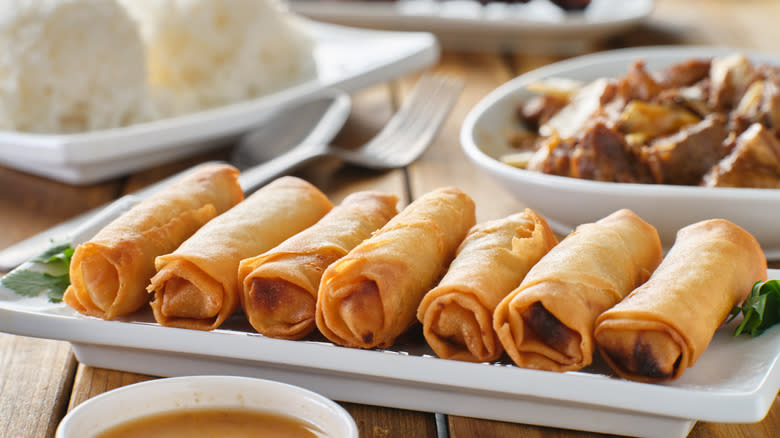Lumpia Shanghai: The History Behind The Filipino Egg Roll

Given its name, one may think the dish lumpia Shanghai (or lumpiang Shanghai) hails from Shanghai, when in fact, it's a quintessential Filipino staple. Lumpia Shanghai are crispy Filipino egg rolls, often stuffed with pork and veggies like carrots and chopped scallions. Across the Philippines and Filipino diasporas, lumpia Shanghai is a common finger food that almost always finds its way to Filipino family gatherings, festive occasions, and potlucks. While the savory spring rolls are what we usually associate with lumpia Shanghai, there are also sweet versions called turon, filled with banana and coated with caramelized sugar.
The history behind lumpia Shanghai is fascinating, though a bit muddy. For centuries, Chinese traders and settlers have influenced the culinary scene in the Phillippines, and immigrants from China's Fujian province brought over the egg roll, which metamorphised into lumpia Shanghai to befit the palates of the locals.
Lumpia is derived from two Hokkien words, lun meaning moist and pia meaning pastry. As for why Shanghai is in the name of this dish when it's not from Shanghai, we can only venture a guess. Given the dish's Chinese origins and Shanghai's status as one of China's most glitzy, renowned, and historically significant cities, this likely explains the name.
Read more: 21 Delicious Ways To Use Up Leftover Rice
Making Lumpia Shanghai Is A Labor Of Love

Filipino cuisine is vibrant and flavorful, but few dishes have survived the test of time and thrived as lumpia Shanghai has. A fun finger food to make and share, albeit a labor of love, lumpia Shanghai is a staple at celebrations and everyday tables alike.
Making lumpia Shanghai starts with prepping the filling, a hearty mix of ground meat (usually pork and sometimes chicken), finely chopped vegetables like carrots and green onions, and aromatics like minced ginger and garlic. The seasoning is usually a mix of soy sauce, salt, pepper, garlic powder, oyster sauce, and sometimes hoisin sauce. To bind the filling together, you can mix in egg. Then, wrap the filling in an egg roll, lumpia wrapper, or thin crepe. Brush the lumpia with egg wash and deep or air fry to perfection.
Each bite is crispy, juicy, and savory. But lumpia Shanghai wouldn't be a finger food without a good dipping sauce to go along with it, and the most common pairing sauces are sweet and sour, often made with banana ketchup or vinegar.
What Differentiates Lumpia Shanghai From Other Egg Rolls

Lumpia Shanghai distinguishes itself from other spring rolls and egg rolls found across Asia and Asian diasporas in several key ways. For instance, Vietnamese spring rolls are wrapped in soft, chewy rice paper. Chinese egg rolls often use thicker and rectangular or square-shaped wrappers. Lumpia Shanghai uses thinner, less doughy wrappers that are circular. This gives Lumpia Shanghai its signature slender and elongated form, setting it apart from the short, thick, and plump shrimp egg rolls often found in Cantonese dim sum restaurants.
Designed for communal dining and as the perfect finger food, lumpia Shanghai encourages guests to enjoy multiple pieces rather than just one or two. Beyond lumpia Shanghai, Filipino cuisine boasts other variations of lumpia, such as banana turon as aforementioned. These days, you can find many creative fillings, like ube, mochi, peach, and mango for sweet lumpia, and crab meat and seafood for savory ones.
With its unique history, characteristic thin, crispy wrapper, elongated shape, and communal serving style, lumpia Shanghai stands out among spring and egg rolls. Lumpia as a dish will continue to withstand the test of time and as a beloved tradition in Filipino dining, inviting everyone to enjoy its many delicious and evolving forms.
Read the original article on Tasting Table.

 Yahoo Finance
Yahoo Finance 